New York City Subway
From Wikipedia, the free encyclopedia
| New York City Subway | |||
|---|---|---|---|

Top: A number 4 train made up of R142 cars enters the Fordham Road station.
Bottom: An E train made up of R160A cars waits for passengers at the 42nd Street – Port Authority Bus Terminal station. |
|||
| Background | |||
| Locale | New York City | ||
| Transit type | Rapid transit | ||
| Number of lines | 34 physical lines (1 under construction) 24 services (1 planned) |
||
| Number of stations | 468 (the MTA classification) 421 (when compared to international standards) 4 under construction |
||
| Daily ridership | 5,380,184 (weekdays, 2012) 3,172,627 (Saturdays, 2012) 2,490,736 (Sundays, 2012)[1] |
||
| Website | mta.info/nyct | ||
| Operation | |||
| Began operation | October 27, 1904 (first underground section) July 3, 1868 (first elevated, rapid transit operation) October 9, 1863 (first railroad operation)[2] |
||
| Operator(s) | New York City Transit Authority (NYCTA) | ||
| Technical | |||
| System length | 209 mi (337 km) (route length) 656 mi (1,056 km) (track length, revenue) 842 mi (1,355 km) (track length, total) |
||
| Track gauge | 4 ft 8 1⁄2 in (1,435 mm) standard gauge | ||
| Electrification | 625V (DC) third rail[3] (600V third rail for some lines) | ||
|
|||
By annual ridership, the New York City Subway is the busiest rapid transit rail system in the United States and in the Americas, as well as the seventh busiest rapid transit rail system in the world; the metro (subway) systems in Tokyo, Seoul, Moscow, Beijing, Shanghai, and Guangzhou record a higher annual ridership.[8] It offers rail service 24 hours per day and every day of the year.[9]
Contents
Overview
Stations are located throughout the boroughs of Manhattan, Brooklyn, Queens and the Bronx. While Staten Island does have a rail line, the Staten Island Railway, it is not officially considered part of the subway, and does not have any direct rail link with the subway system, so any passengers wishing to visit another borough must take a ferry or bus.Almost all routes pass through Manhattan (except the G, Franklin Avenue Shuttle and Rockaway Park Shuttle trains), and most of the 468 stations are served 24 hours a day.[10] Contrary to its name, the New York City Subway system is not entirely underground. Large portions of it (especially outside Manhattan) are elevated, on embankments, or in open cuts, and a few stretches of track run at ground level. In total, 40% is at or above ground.

An entrance to the Times Square – 42nd Street station, the busiest station of the New York City Subway.[11]
In 2005, the New York City Subway hit a 50-year record in usage with a ridership of 1.45 billion.[12] The trend toward higher ridership continued into 2008; MTA released figures that subway use was up 6.8% for January and February as higher gasoline prices encouraged riders to use mass transit over automobiles.[13]
The Citizens Budget Commission reported in 2011 that the subway system was among the most cost-efficient in the country, with the lowest cost per passenger trip and second-lowest cost per passenger mile.[14]
According to the United States Department of Energy, energy expenditure on the New York City Subway rail service was 3492 BTU/passenger mile (2289 kJ/passenger km) in 1995. This compares with 3702 BTU/passenger mile (2427 kJ/passenger km) for automobile travel.[15] However, the figure for automobiles is averaged over the entire United States. Driving a car in New York City is significantly less efficient due to the highly urbanized environment.[16]
History
Main article: History of the New York City Subway
The Great Blizzard of 1888 helped demonstrate the benefits of an underground transportation system. The first underground line of the subway opened on October 27, 1904, almost 35 years after the opening of the first elevated line in New York City, which became the IRT Ninth Avenue Line. The oldest structure still in use opened in 1885 as part of the BMT Lexington Avenue Line in Brooklyn and is now part of the BMT Jamaica Line. The oldest right-of-way, that of the BMT West End Line, was in use in 1863 as a steam railroad called the Brooklyn, Bath and Coney Island Rail Road.
In 1940, the two private systems were bought by the city and some elevated lines closed immediately while others closed soon after. Integration was slow, but several connections were built between the IND and BMT, and now operate as one division called the B Division. Since the IRT tunnel segments are too small and stations too narrow to accommodate B Division cars, and contain curves too sharp for B Division cars, the IRT remains its own division, A Division.
The New York City Transit Authority, a public authority presided by New York City, was created in 1953 to take over subway, bus, and streetcar operations from the city, and placed under control of the state-level Metropolitan Transportation Authority in 1968.

The Cortlandt Street station after the World Trade Center collapse
The September 11 attacks resulted in service disruptions on lines running through Lower Manhattan, particularly the IRT Broadway – Seventh Avenue Line, which ran directly underneath the World Trade Center between the Chambers Street and Rector Street stations. Sections of the tunnel, as well as the Cortlandt Street station, which was directly underneath the Twin Towers, were severely damaged by the collapse and had to be rebuilt, requiring suspension of service on that line south of Chambers Street. Ten other nearby stations were closed while dust and debris were cleaned up. By March 2002, seven of those stations had reopened. The rest (except for Cortlandt Street on the IRT Broadway – Seventh Avenue Line) reopened on September 15, 2002 along with service south of Chambers Street.[19][20]
Construction methods

42nd Street station improvements, 1987.
About 40% of the subway system runs on surface or elevated tracks, including steel or cast iron elevated structures, concrete viaducts, embankments, open cuts and surface routes. All of these construction methods are completely grade-separated from road and pedestrian crossings, and most crossings of two subway tracks are grade-separated with flying junctions. The sole exceptions are the 135th Street junction and the Myrtle Avenue junction, whose tracks both intersect at the same level.
More recent projects, like the extension of the IRT Flushing Line and the IND Second Avenue Line, use tunnel boring machines to build the subway tunnels.
Lines and routes
Further information: List of New York City Subway lines and List of New York City Subway services
Many rapid transit systems run relatively static routings, so that a
train "line" is more or less synonymous with a train "route". In New
York, routings change often as new connections are opened or service
patterns change. Within the nomenclature of the subway,
the "line" describes the physical railroad track or series of tracks
that a train "route" uses on its way from one terminal to another.
"Routes" (also called "services") are distinguished by a letter or a
number and "Lines" have names. They are also designations for trains, as
exemplified in the Billy Strayhorn song Take the "A" Train.There are 24 train services in the subway system, including three short shuttles. Each route has a color and a local or express designation representing the Manhattan trunk line of the particular service. The color lime green is exclusively assigned to the Crosstown Line route, which operates entirely outside Manhattan, while the shuttles are all assigned dark slate gray.[22] The current color system depicted on official subway maps was proposed by R. Raleigh D'Adamo, a lawyer who entered a contest sponsored by the Transit Authority in 1964. D'Adamo proposed replacing a map that used only three colors (representing the three operating entities of the subway network) with a map that used a different color for each service. D'Adamo's contest entry shared first place with two others and led to the Transit Authority adopting a multi-colored scheme.[23] The lines and services are not referred to by color (e.g., Blue Line or Green Line).[24][25]
Though the subway system operates on a 24-hour basis, some of the designated routes do not run, run as a shorter route or run with a different stopping pattern during late night hours. In addition to these regularly scheduled changes, because there is no nightly system shutdown for maintenance, tracks and stations must be maintained while the system is operating. To accommodate such work, services are usually changed during midday, overnight hours, and weekends.[26]
Trunk lines
Main article: List of New York City Subway lines#Line listing
| Primary Trunk line | Color[27][28] | Pantone [29] | Service bullets |
|---|---|---|---|
| IND Eighth Avenue Line | Vivid blue | PMS 286 | |
| IND Sixth Avenue Line | Bright orange | PMS 165 | |
| IND Crosstown Line | Lime green | PMS 376 | |
| BMT Canarsie Line | Light slate gray | 50% black | |
| BMT Nassau Street Line | Terra cotta brown | PMS 154 | |
| BMT Broadway Line | Sunflower yellow | PMS 116 | |
| IRT Broadway – Seventh Avenue Line | Tomato red | PMS 185 | |
| IRT Lexington Avenue Line | Apple green | PMS 355 | |
| IRT Flushing Line | Raspberry | PMS Purple | |
| Shuttles | Dark slate gray | 70% black |
Routes
Subway map
The current official transit maps of the New York City Subway are based on a 1979 design by Michael Hertz Associates. The maps are not geographically accurate due to the complexity of the system (i.e. Manhattan being the smallest borough, but having the most services), but are known to help tourists navigate the city, as major city streets are shown alongside the subway stations serving them. The newest edition of the subway map, which took effect on June 27, 2010, reflects the latest service changes and also makes Manhattan bigger and Staten Island smaller.[30][31] A late night-only version of the map was introduced on January 30, 2012.[32]Part of the reason for the current incarnation is that earlier diagrams of the subway (the first being produced in 1958), while being more aesthetically pleasing, had the perception of being more geographically inaccurate than the diagrams today. The design of the subway map by Massimo Vignelli, published by the MTA between 1972 and 1979, has since become recognized in design circles as a modern classic; however, the MTA deemed the map flawed due to its placement of geographical elements.[33][34]
On September 16, 2011, the MTA introduced a Vignelli-style interactive subway map, called "The Weekender",[35] to its website.[36] As the title suggests,[37] it is a way for riders to get information about any planned work, from late Friday night to early Monday morning, that is going on either on a service(s) or station(s) of the subway during the weekend only.[38][39] On June 11, 2012, the MTA duplicated "The Weekender" site as a free mobile app download for iOS.[40][41] On November 29, 2012, an Android version of the app was released.[42]
There are several privately produced schematics which are available online or in published form, such as those by Hagstrom Map.[43] Additionally, the New York City subway map has served as the subject of artistic endeavors. Among these are works by Fadeout Design and by Alexander Chen.[44][45]
Stations facilities and amenities
Main article: List of New York City Subway stations

Entrance to Broad Street station with its red lamps
Station and concourse
Many stations have mezzanines. These allow for passengers to enter from multiple entrances and proceed to the correct platform without having to cross the street before entering. They also allow for crossover between the uptown and downtown platforms.Passengers enter a subway station through stairs towards station booths and vending machines to buy their fare, which is currently stored in a MetroCard. After swiping the card at a turnstile, customers continue to the platforms. Some subway lines in northern Manhattan and the other boroughs have elevated tracks to which passengers climb up to the platforms and station houses via stairs, escalators, or elevators.
Globe lamps
At most of the system's entrances and exits sits a lamp post or two bearing a colored spherical lamp. These lights were once used to indicate the station's availability. A green lamp means that the station is open and running 24 hours a day, while a red lamp means that it is an exit-only or part-time. A yellow lamp once indicated a part-time station, but in an attempt to simplify the system, was eventually phased out and replaced by red lamps, now indicating both a part-time entrance and exit-only. With the introduction of the MetroCard in 1994, some station entrance/exit configurations have been changed by merging some entrances and exits, thus making this light system no longer accurate.[46]Platforms
A typical subway station has waiting platforms ranging from 500 to 600 feet (150 to 180 m) long, though some IND platforms may be as long as 660 to 745 feet (201 to 227 m) long.[47] Due to the large number of transit lines, one platform or set of platforms often serve more than one service. Passengers need to look at the overhead signs at the platform entrance steps and over each track to see which trains stop there and when, and at the arriving train to see which one it is.There are a number of common platform configurations:
- On a double track line, a station may have one center island platform used for trains in both directions, or 2 side platforms, one for a train in each direction.
- For lines with three or four tracks with express service, local stops will have side platforms and the middle one or two tracks will not stop at the station. On these lines, express stations have two island platforms, one for the local and express in one direction, and another for the local and express in the other direction. Each island platform provides a cross-platform interchange between local and express services. Almost everywhere expresses run, they run on the inner one (of 3) or two (of 4) tracks and locals run on the outer two tracks. In a 3-track configuration, the center express track can be used toward the center of the city in the morning and away from the center in the afternoon and evening, though not every 3-track line has that express service.
There is one notable six-track local station, DeKalb Avenue, where trains to or from the Manhattan Bridge (B D N Q R) either stop at the outer tracks of one of the island platforms, or pass through and bypass the station on the middle tracks ("express tracks") (D N). Trains to or from the Montague Street Tunnel (R) stop across the platform from the respective outer track, between the outer and bypass tracks.
Artwork
Many stations are decorated with intricate ceramic tile work, some of it dating back to 1904 when the subway first opened. The subway tile artwork tradition continues today.Accessibility

The Crown Heights – Utica Avenue station is one of a group of stations that became accessible after station reconstruction
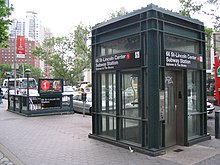
Street elevator serving as an entrance to the 66th Street – Lincoln Center station
Main article: List of accessible New York City Subway stations
Since the majority of the system was built before 1990, the year the Americans with Disabilities Act
(ADA) went into effect, many New York City Subway stations were not
designed to be handicapped-accessible. Since then, elevators have been
built in newly constructed stations to comply with the ADA. (Most
grade-level stations required little modification to meet ADA
standards.) In addition, the MTA identified "key stations," high-traffic
and/or geographically important stations, which must conform to the ADA
when they are extensively renovated.[52] As of June 2011, there are 89 currently accessible stations; many of them have AutoGate access.[53][54][55]Entertainment
Main article: Music Under New York

A typical scene of musicians performing on the platform of the Broadway – Lafayette St station.
At present, more than 100 soloists and groups participate in MUNY providing over 150 weekly performances at 25 locations throughout the transit system. For example Natalia Paruz, a musical saw player, plays at Union Square. In addition, any musician/entertainer may perform in subway mezzanines and platforms. On platforms, there may be no amplifications as this is part of MTA policies:[62]
| “ | The New York City Transit (NYCT) is a subdivision of the Metropolitan Transportation Authority (MTA) that operates the city's subways and buses. The NYCT authorizes these types of free expression in subway stations: "Public speaking; distribution of written materials; solicitation for charitable, religious or political causes; and artist performances, including the acceptance of donations." | ” |
Restrooms
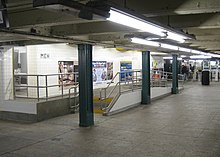
Restrooms at Church Avenue
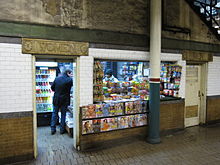
Former women's restroom converted into newsstand at Astor Place
Retail
Some platforms have newspaper stands that sell various items including newspapers and food. The MTA also installed retail spaces within paid areas in selected stations, including the station concourses of the Times Square complex and the Sixth Avenue concourse at 42nd Street – Bryant Park.According to the MTA, the New York City Subway is home to 345 retail spaces, making over US$70 million in rent and licensing fees in 2009 for the authority. It is continuing to make efforts in attracting more diverse retailers and vendors to set up shop in the subway system.[65]
Connections
Rapid transit and rail connections are available at designated stations to Amtrak, Long Island Rail Road, AirTrain JFK, Metro-North Railroad, New Jersey Transit and PATH. Connections to the Staten Island Ferry and privately operated ferries such as NY Waterway and New York Water Taxi, as well as intercity and commuter bus lines at the Port Authority Bus Terminal and George Washington Bridge Bus Terminal, are also available. Free MetroCard-only transfers to buses are available to MTA New York City Transit buses (including the bus rapid transit Select Bus Service), MTA Bus Company, NICE buses (Nassau County) and Bee-Line buses (Westchester County).Rolling stock
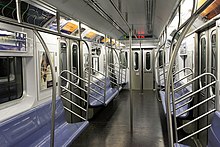
Interior of an R142A train car
Main article: New York City Subway rolling stock
As of June 2011, the New York City Subway has 6,292 cars on the roster.[66]
A typical New York City Subway train consists of 8 to 11 cars, although
shuttles can have as few as two, and the train can range from 150 to
600 feet (46 to 183 m) in length.The system maintains two separate fleets of cars, one for the Division A routes and another for the Division B routes. All Division B equipment is about 10 feet (3.05 m) wide and either 60 feet 6 inches (18.44 m) or 75 feet (22.86 m) long whereas Division A equipment is approximately 8 feet 9 inches (2.67 m) wide and 51 feet 4 inches (15.65 m) long. There is also a special fleet of Division B cars that is used for operation in the BMT Eastern Division, consisting of R32 / R42 cars in married pairs and R143 / R160A cars in four-car sets. Due to clearance issues on various sharp curves, 75-foot (22.86 m) long cars are not permitted on BMT Eastern Division trackage.
Cars purchased by the City of New York since the inception of the IND and the other divisions beginning in 1948 are identified by the letter “R” followed by a number; e.g.: R32. This number is the contract number under which the cars were purchased. Cars with nearby contract numbers (e.g.: R1 through R9, or R26 through R29, or R143 through R160B) may be relatively identical, despite being purchased under different contracts and possibly built by different manufacturers.
The MTA has been incorporating newer subway cars into its stock since the late 1990s. Since 1999, the R142, R142A, R143, and R160A/R160B cars have been placed into service.[67][68] These cars feature recorded announcements for station information, closing doors, and other general messages in lieu of conductor announcements, although live conductor announcements can still be made. The recordings began in the late 1990s and featured Bloomberg Radio on-air speakers, who volunteered at the request of their employer and then-future city mayor Michael Bloomberg. Voices include Jessica Ettinger Gottesman, Diane Thompson, Charlie Pellett, and Catherine Cowdery. With regards to why certain messages are voiced by males and others by females, MTA spokesperson Gene Sansone said in 2006 that, “Most of the orders are given by a male voice, while informational messages come from females. Even though this happened by accident, it is a lucky thing because a lot of psychologists agree that people are more receptive to orders from men and information from women”.[69]
On March 24, 2012, the MTA announced that it ordered 300 R179 subway cars from Bombardier.[70][71] The total price of the contract is US$599 million, with the first test train arriving in late 2014.
Fares
Main article: New York City transit fares
Riders pay a single fare to enter the subway system and may transfer
between trains at no extra cost until they exit via station turnstiles;
the fare is a flat rate regardless of how far or how long the rider
travels. Thus, riders must swipe their MetroCard upon entering the subway system, but not a second time upon leaving.As of 2013, nearly all fares are paid via a magnetic-stripe card system called "MetroCard". The base fare is $2.50 when purchased in the form of a reusable "pay per ride" MetroCard. Single-use cards may be purchased for $2.75, and 7-day and 30-day unlimited ride cards can lower the effective per-ride fare significantly. Reduced fares are available for the elderly and people with disabilities.
Token and change
From the inauguration of IRT subway services in 1904[72] until the unified system of 1948 (including predecessor BMT and IND subway services), the fare for a ride on the subway of any length was 5 cents (nickel). On July 1, 1948, the fare was increased to 10 cents (dime), and since then has steadily risen. When the New York City Transit Authority was created in July 1953, the fare was raised to 15 cents and a token issued. Until April 13, 2003, riders paid the fare with tokens purchased from a station attendant. The tokens were changed periodically as prices changed. For the 75th anniversary of the subway in 1979 (also called the Diamond Jubilee), a special token with a small off-center diamond cutout and engraved images of a 1904 subway car and kiosk were issued. Many were purchased for keepsakes and were not used for rides. The last iteration of tokens featured a hole in the middle and phased out in 2003 when the fare rose to $2.[73]Token sucking
It was a common scam to circumvent the payment of fares by jamming the token slot in an entrance gate with paper. A passenger would insert a token into the turnstile, be frustrated when it did not open the gate, and have to spend another token to enter at another gate. A token thief would then suck the token from the jammed slot with their mouth. This could be repeated many times as long as no police officers spotted the activity. Some token booth attendants sprinkled chili powder in the slots to discourage "token sucking".[74] Token sucking (also known as stuff 'n' suck) was charged under theft of services, criminal tampering and criminal mischief.[75]Token War with Connecticut
Transit riders discovered in the early 1980s that tokens purchased for use in the Connecticut Turnpike toll booths were of the same size and weight as New York City subway tokens. Since they cost less than one third as much, they began showing up in subway collection boxes regularly.[76] Connecticut authorities initially agreed to change the size of their tokens,[77] but later reneged and the problem went unsolved until 1985, when Connecticut discontinued the tolls on its turnpike.[78] At that time, the MTA was paid 17.5 cents for each of more than two million tokens that had been collected during the three-year "token war."[78]MetroCard
Main article: MetroCard (New York City)
In 1993, the subway system introduced a fare system called the
MetroCard, which allows riders to use cards that store the value equal
to the amount paid to a station booth clerk or vending machine. The
MetroCard was enhanced in 1997 to allow passengers to make free
transfers between subways and buses within two hours; several
MetroCard-only transfers between subway stations
were added in 2001. With the addition of unlimited-ride MetroCards in
1998 (for 7-day and 30-day periods, later 1-day "Fun Pass" and 14-day
periods, both of which have been discontinued), the New York City
Transit system was the last major transit system in the United States
with the exception of BART in San Francisco to introduce passes for unlimited bus and rapid transit travel.[79]Renovation and expansion plans
Current expansion projects include the:- Second Avenue Subway on the Upper East Side of Manhattan
- 7 Subway Extension to the west side of Manhattan
- Fulton Center in Lower Manhattan[80][81][82][83][84][85]
Operations
Pending legislation would merge the subway operations of MTA New York City Transit with Staten Island Railway to form a single entity called MTA Subways.[86] The Staten Island Railway operates with R44 subway cars on a fully grade-separated right-of-way, but is typically not considered part of the subway, and is connected only via the free, city-operated Staten Island Ferry.In the early 21st century, plans resurfaced for a major expansion, the Second Avenue Subway. This line had been planned in the 1920s, but was delayed several times since. Construction was started in the 1970s, but discontinued due to the city's fiscal crisis. Some small portions remain intact in Chinatown, the East Village, and the Upper East Side, but they are each quite short and thus remain unused.[87]
FASTRACK
In 2012, the MTA introduced a new maintenance program, FASTRACK, to speed up repair work. This program involves a more drastic approach than previous construction, and shuts down an entire trunk line in Manhattan for four consecutive weeknights.[88] According to the MTA, this new program proved much more efficient and quick than regular service changes, especially because it happened at night and not the weekend, when most transit closures had occurred before.[89]
FASTRACK on the IND Eighth Avenue Line
- IRT Lexington Avenue Line from Grand Central – 42nd Street to Atlantic Avenue – Barclays Center
- IND Sixth Avenue Line from 59th Street – Columbus Circle to West Fourth Street – Washington Square
- IRT Broadway – Seventh Avenue Line from 34th Street – Penn Station to Atlantic Avenue – Barclays Center
- IND Eighth Avenue Line from 59th Street – Columbus Circle to Jay Street – MetroTech
- BMT Broadway Line from Queensboro Plaza to Court Street
- IND Eighth Avenue Line from 168th Street to Inwood – 207th Street
- IND Concourse Line from 161st Street – Yankee Stadium to Norwood – 205th Street
- IND Queens Boulevard Line from Fifth Avenue / 53rd Street to Jackson Heights – Roosevelt Avenue
- IRT Nostrand Avenue Line from Franklin Avenue to Flatbush Avenue – Brooklyn College
- IND Concourse/Eighth Avenue lines from 59th Street – Columbus Circle to 161st Street – Yankee Stadium and 168th Street
- BMT Nassau Street Line from Broad Street to Essex Street
- BMT Fourth Avenue Line from 36th Street to Bay Ridge – 95th Street
- IRT Lexington Avenue Line from Grand Central – 42nd Street to 125th Street[93]
Technology

New train arrival signs on the BMT Canarsie Line
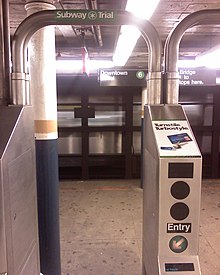
RFID trial on the IRT Lexington Avenue Line
Train arrival times
In 2003, the MTA signed a $160 million contract with Siemens Transportation Systems to install digital next-train arrival message boards, called Public Address/Customer Information Screens (PA/CIS) at 158 of its IRT stations.[96] These signs were to be different from the current LED signs that display the current date and time. However, many problems arose with the software used in Siemens programming, and the MTA stopped payment to the company in May 2006.[97] The MTA threatened to drop Siemens, but about a month later Siemens announced they had fixed the problem. The signs were scheduled to begin operation in late 2007.[98]A different system was eventually developed, tested, and installed successfully on the L train.[99] In 2008, system-wide roll-out was pushed back to 2011, with the MTA citing technical problems.[100][101] However, in December 2009 an initial trial was implemented at three stations along the IRT Pelham Line (6 <6> trains) in the Bronx.[102] The announcements are voiced by radio traffic reporter Bernie Wagenblast[103] and Carolyn Hopkins.[104] As of March 9, 2011, the system is now active in about 110 stations all over the New York City Subway.[105][106][107][108][109][110][111]
2006 PayPass only trial
The MTA signed a deal with MasterCard in the first few months of 2006 to test out a new RFID card payment scheme.[112] Customers had to sign up at a special MasterCard website and use a MasterCard PayPass credit or debit card/tag to participate. Participating stations included:[113]- IRT Lexington Avenue Line (4 5 6 <6> trains) from both 138th Street stations in the Bronx to Borough Hall, Brooklyn,
- Court Square – 23rd Street in Queens for the E M trains,
- and Court Square for the 7 <7> trains.
2010 PayPass and PayWave trial
In light of the success of the first Paypass pilot project in 2006, another trial was started by the MTA. This one started on June 1, 2010 and ended on November 30, 2010. The first two months started with the customer just using the MasterCard PayPass debit or credit card.[115][116][117][118][119] However, this trial was the debut of having a rider use the VISA PayWave debit or credit card to enter the system, which started on August 1, 2010.[120] For six months, a rider could use either a MasterCard Paypass or VISA PayWave credit/debit card to pay for a fare on the following locations or routes:- the IRT Lexington Avenue Line (4 5 6 <6> trains) from 138th Street – Grand Concourse or Third Avenue – 138th Street stations in the Bronx to Borough Hall station in Brooklyn,
- the M14, M23, M79, M86, M101, M102, M103 New York City Transit local bus routes, and the BxM7 MTA Bus express bus route,
- most of the Port Authority Trans-Hudson (PATH) train stations (except for Christopher Street and 9th Street); and,
- #6 (Ocean Avenue – Journal Square), #80 (Newark Avenue), and #87 (King Drive) New Jersey Transit bus routes.
- A new route service was added at an unknown date. Here, one can now try this trial to use the Newark Liberty International Airport's AirTrain monorail system to terminals A, B, and C and the long-term parking areas of the airport. However, it is only good for going to the airport, away from the Newark Liberty International Airport New Jersey Transit train station. This service does not apply heading to exit the airport and towards the mentioned Newark Liberty International Airport station.
- "pay-as-you-go" RFID card scan at select turnstiles or locations; or,
- pre-funded fares via a pilot website called the "NY/NJ Transit Trial"[121] for multiple and unlimited ride discounts. Effective October 16, 2010, pre-funded fares are not available in the trial website.
Automation
Main article: Automation of the New York City Subway
In the late 1990s and early 2000s, the MTA began the process of automating the subway. Beginning with the BMT Canarsie Line (L train) and the IRT Flushing Line (7 <7> trains),[122] the MTA has plans to eventually automate a much larger portion, using One Person Train Operation (OPTO) in conjunction with Communication-Based Train Control (CBTC). Siemens Transportation Systems built the CBTC system on the Canarsie line. Thales
is building the CBTC system for the Flushing Line. In late winter 2008,
the MTA embarked on a 5-week renovation and upgrade project on the 7
train between Flushing – Main Street and 61st Street – Woodside
to upgrade signaling and tracks for CBTC. On February 27, 2008, the MTA
issued an Accelerated Capital Program to continue funding the
completion of CBTC for the 7 train and to begin on the IND Queens Boulevard Line (E F M R trains). The proposed plan is estimated to cost US $1.4 million.[123](p. 15–16)The New York City Subway uses a system known as Automatic Train Supervision (ATS) for dispatching and train routing on the A Division (the Flushing line, and the trains used on the 7 service, do not have ATS.) ATS allows dispatchers in the Operations Control Center (OCC) to see where trains are in real time, and whether each individual train is running early or late. Dispatchers can hold trains for connections, re-route trains, or short-turn trains to provide better service when a disruption causes delays.
Help Point
The MTA set up another technology pilot project for the New York City Subway called "Help Point" in April 5, 2011. Help Point is a new digital-audio communications system that lets a rider access it, in case of an emergency or needing subway information for travel directions.[124] The top button is labeled red for emergencies towards the Rail Control Center. The bottom button is labeled green towards a MTA station agent for any inquiries. All units are equipped with a microphone to speak into and a speaker to hear answers to the rider from a MTA worker.[125] Also, the test units were equipped for the hearing impaired (under ADA compliance).The two subway stations that were part of this trial were on the IRT Lexington Avenue Line. They were the 23rd Street and the Brooklyn Bridge – City Hall stations. The Help Points at the Brooklyn Bridge – City Hall station were wireless and the 23rd Street station ones were hard-wired, to test which type of transmission is best for the subway. If the test project is successful, then this communications system will replace the existing Customer Assistance Intercom (CAI) units on all 468 subway stations in the future.[126][127]
On March 6, 2012, the MTA decided that all CAI units will be replaced with wireless Help Points in all subway stations, with optional cameras to each unit.[128]
On The Go! Travel Station
On September 19, 2011, the MTA set up another pilot project, an online, interactive touchscreen computer program called "On The Go! Travel Station" (OTG). It lists any planned work or service changes occurring on the subway as well as information to help travelers find landmarks or locales near the stations with an OTG outlet. The first station to test this new technology was Bowling Green on the IRT Lexington Avenue Line.[129] Other stations scheduled to participate in this program were Penn Station (with the LIRR), Grand Central Terminal (with Metro-North), Atlantic Avenue – Barclays Center in Brooklyn, and Jackson Heights – Roosevelt Avenue / 74th Street – Broadway in Queens.[130]New and existing On the Go! kiosks will receive an interface overhaul as a result of the MTA's partnership with Control Group, a technology and design consultancy firm. Control Group is adding route lookup, countdown to train arrivals, and service alerts. The next iteration of 47–90 interactive wayfinding kiosks is scheduled for deployment in 2013.[131]

An indoor antenna which is part of the distributed antenna system installed by Transit Wireless inside a station
Cellular phone and wireless data
New York City Subway began to provide underground cellular phone with voice and data service, and free Wi-Fi to passengers in 2011 at six stations. The new network was installed and owned by Transit Wireless as part of company's $200 million investment. The company expanded the services to 30 more stations in 2013 and signed an agreement with all 4 major wireless network operators to allow their cellular phone customers to use its network. The MTA and Transit Wireless are splitting the fees received from those wireless carriers for the usage of the network. The Wi-Fi service is operated by Boingo Wireless.[132]Safety and security
Crime, train accidents, suicides and threats of terrorism all impact the subway system.Train movement safety
Safe train operation on the whole New York City Subway is ensured by a combination of interlocking, signalling, wayside train protection and wayside speed control layouts.[133] However, no technical system is free of hazards.Interlocking
Like the railways, the subway used mechanical interlocking in early days and introduced relay interlocking later. Computer-based interlockings are state-of-the-art systems offering additional functions. But independently from the applied technology, the interlocking logic stayed the same: "Control lengths" along the selected route to be set until the target signal plus an additional overlap (safety distance) must be clear of any trains or cars to be able to clear the signal for the according route and target signal. "Single line signal diagrams" show all defined "control lengths" (and routes) for each interlocking tower.Signalling
Main article: Automation of the New York City Subway
New York City Subway generally distinguishes signals into:- automatic signals, controlled only by train movements
- approach signals, like automatic signals, can be forced to switch to stop aspect by interlocking tower
- home signals, route set by interlocking tower
- additional signals (call-on, dwarf, marker, sign, time signals)
- stop (one red light); with special rules for call-on and timer signals
- clear, next signal at clear or caution (one green light)
- proceed with caution, be prepared to stop at next signal (one yellow light)
- upper signal head for speeds
- lower signal head for routes (with main route shown green and diverging route shown yellow)
Train protection
Subway trains are stopped mechanically at all signals showing "stop" aspects by automatic train stops located on the right side of IRT tracks and the left side of BMT/IND tracks; all cars are equipped with tripcocks. Although this is a simple principle of train stops, that wayside trippers must not be moved to trip ("stop") position until it is guaranteed that the train has fully passed the signal with all its cars.In the middle of all New York City subway platforms is a black-and-white striped board at which all conductors are required to point when the train is stopped at the proper location.[134]
Speed control
Speed control on the subway is ensured by "Time Signals." A timer is started as soon as the train passes a certain point and will clear the signal ahead as soon as the predefined time elapsed; the minimum time is calculated from the speed limit and the distance between start of timer and signal. "Time Signals" are distinguished into "Grade Timer" for speed supervision at grades, curves or in front of buffer stops, and in "Station Timer" for low-speed entrance into stations in order to reduce train headways.CBTC
Communication-Based Train Control (CBTC) is the state-of-the-art system for signalling, Automatic Train Protection and speed control being installed in the subway system within its current big automation project.Train accidents
Including the predecessors of the New York City Subway, at least 55 train accidents have been recorded since 1918, when a train bound for South Ferry smashed into two trains halted near Jackson Avenue on the IRT White Plains Road Line in the Bronx.[135] The deadliest accident, the Malbone Street Wreck, happened November 1, 1918 beneath the intersection of Flatbush Avenue, Ocean Avenue, and Malbone Street (the latter of which is now Empire Boulevard) near the Prospect Park station of the then-BRT Brighton Line in Brooklyn, killing 93 people.[136]Passenger safety
Crime
The subway carries up to 1.5 billion passengers a year. Crime rates have shown variations over time, with a drop starting in the '90s and continuing today.[137][138]In order to fight crime, various approaches have been used.[139] A new initiative by the MTA to prevent crime is to ban people who commit one in the subway system from entering it for a certain length of time.[140] In the '60s, for example, mayor Robert Wagner ordered an increase in the Transit Police force from 1,219 to 3,100 officers. During the hours at which crimes most frequently occurred (between 8:00pm and 4:00 am), the officers went on patrol in all stations and trains. In response, crime rates decreased, as extensively reported by the press.[141]
In July 1985 however, the Citizens Crime Commission of New York City published a study showing riders abandoning the subway, fearing the frequent robberies and generally bad circumstances.[142]
To counter these developments, policy that was rooted in the late 1980s and early 1990s was implemented.[143][144] In line with this Fixing Broken Windows philosophy, the New York City Transit Authority (NYCTA) began a five-year program to eradicate graffiti from subway trains in 1984.[145]
In 1989 the Metropolitan Transportation Authority asked the transit police (then located within the NYCTA) to focus on minor offenses such as fare evasion. In the early nineties, the NYCTA adopted similar policing methods for Penn Station and Grand Central Terminal.
In 1993, Mayor Rudy Giuliani took office and with Police Commissioner Howard Safir the strategy was more widely deployed in New York under the rubrics of "zero tolerance" and "quality of life". Crime rates in the subway and city dropped,[146] prompting New York Magazine to declare "The End of Crime as We Know It" on the cover of its August 14, 1995 edition.
Giuliani's campaign credited the success to the zero tolerance policy.[147] The extent to which his policies deserve the credit is disputed.[148]
Incoming New York City Police Department Commissioner William J. Bratton and author of Fixing Broken Windows, George L. Kelling, however, stated the police played an "important, even central, role" in the declining crime rates.[149] The trend continued and Giuliani's successor, Mayor Michael Bloomberg, stated in a November 2004 press release that "Today, the subway system is safer than it has been at any time since we started tabulating subway crime statistics nearly 40 years ago."[150]
Suicides
A portion of subway-related deaths in New York consists of suicides committed by jumping in front of an oncoming train.Between 1990 and 2003, 343 subway-related suicides have been registered out of a citywide total of 7,394 (4.6%) and subway-related suicides increased by 30%, despite a decline in overall suicide numbers.[151]
Several planned stations in the New York City Subway may possibly feature platform screen doors. This includes the 7 Subway Extension,[152] and Second Avenue Subway.[153] Although these doors are designed to improve airflow in stations, they also prevent people from falling or jumping onto the tracks.[154]
Photography
After the September 11 attacks in New York, the MTA was extremely wary of anyone taking photographs or recording video inside the system and proposed banning all photography and recording in a meeting around June 2004.[155] However, due to strong response from both the public and from civil rights groups, the rule of conduct was dropped. In November 2004, the MTA again put this rule up for approval, but was again denied,[156] though many police officers and transit workers still confront or harass people taking photographs or video.[157]On April 3, 2009, the NYPD issued a directive to officers stating that it is legal to take pictures within the subway system so long as it is not accompanied with suspicious activity.[158]
Currently, the MTA Rules of Conduct,[62] Restricted Areas and Activities section states that anyone may take pictures or record video, provided that they do not violate MTA regulations:
- Section 1050.9 Restricted areas and activities.
- Photography, filming or video recording in any facility or conveyance is permitted except that ancillary equipment such as lights, reflectors or tripods may not be used. Members of the press holding valid identification issued by the New York City Police Department are hereby authorized to use necessary ancillary equipment. All photographic activity must be conducted in accordance with the provisions of this Part.[159]
Terrorism prevention and foiled plot
See also: New York City Transit Police
On July 22, 2005, in response to bombings in London, the New York City Transit Police introduced a new policy of randomly searching passengers' bags as they approached turnstiles. The NYPD claimed that no form of racial profiling
would be conducted when these searches actually took place. The NYPD
has come under fire from some groups that claim purely random searches
without any form of threat assessment would be ineffectual. "This NYPD
bag search policy is unprecedented, unlawful and ineffective," said
Donna Lieberman, Executive Director of the NYCLU.
"It is essential that police be aggressive in maintaining security in
public transportation. But our very real concerns about terrorism do not
justify the NYPD subjecting millions of innocent people to
suspicionless searches in a way that does not identify any person
seeking to engage in terrorist activity and is unlikely to have any
meaningful deterrent effect on terrorist activity."[160] The searches were upheld by the United States Court of Appeals for the Second Circuit in MacWade v. Kelly.On April 11, 2008, MTA received a Ferrara Fire Apparatus Hazardous Materials Response Truck, which went into service three days later. It will be used in the case of a chemical or bioterrorist attack.[161]
Najibullah Zazi and others were arrested in September 2009 and pled guilty in 2010 to being part of an al-Qaeda plan to undertake suicide bombings on the New York City subway system.[162][163]
Challenges
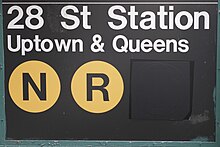
28th Street station after the W train was discontinued in mid-2010. Note the dark grey tape masked over the W bullet.
2009–2010 budget cuts
The MTA faced a budget deficit of US$1.1 billion in 2009. Fare increases (three times from 2008 to 2010) and service reductions (including the elimination of two part-time subway services, the V and W, increased weekend headways on other services, and shortening, rerouting, or elimination of many bus routes) were enacted to balance the deficit.
The interior of an F train during morning rush hour
Capacity constraints
Several subway lines have reached their operational limits in terms of train frequency and passengers, according to data released by the Transit Authority. All but one of the A Division services as well as the E and L trains are beyond capacity, as well as portions of the N train.[164][165]The Second Avenue Subway will relieve pressure on the Lexington Avenue Line (4 5 6 <6> trains) when its first segment begins operating in 2016, and CBTC installation on the Flushing Line is expected to increase the rate of trains per hour on the 7 <7> trains, but no such relief is planned for other crowded lines. However, the Long Island Railroad East Side Access project is expected to bring many more commuters to the Lexington Avenue Line at about the same time, further overwhelming its capacity. Because new subway construction can require years to plan and complete, the Transit Authority can only turn to increased bus service to manage demand in the short run, until automation of the subways using CBTC allows trains to run with less headway.
Subway flooding
Service on the subway system is occasionally disrupted by flooding from rainstorms, even minor ones.[166] Rainwater can disrupt signals underground and require the electrified third rail to be shut off. Since 1992, $357 million has been used to improve 269 pump rooms. As of August 2007, $115 million has been earmarked to upgrade the remaining 18 pump rooms.[167] Despite these improvements, the transit system continues to experience flooding problems.On August 8, 2007, after more than 3 inches (76 mm) of rain fell within an hour, the subway system flooded, causing almost every subway service to either be disabled or seriously disrupted, effectively halting the morning rush. This was the third incident in 2007 in which rain disrupted service. The system was disrupted on this occasion because the pumps and drainage system can handle only a rainfall rate of 1.75 inches (44 mm) per hour; the incident's severity was aggravated by the scant warning as to the severity of the storm.[168] (p. 10) In late August 2007, MTA Engineer Phil Kollin announced new plans to create a system that would pump water away from the third rail.
On August 27, 2011, due to the approach of Hurricane Irene, the MTA suspended subway service at 12:00 noon in anticipation of heavy flooding on tracks and in tunnels. It was the first weather-caused shutdown in the history of the system.[169] Service was restored by Monday, August 29.[170][171]
In addition, as part of a $130 million and an estimated 18-month project, the MTA began installing new subway grates in September 2008 in an attempt to prevent rain from overflowing into the subway system. The metallic structures, designed with the help of architectural firms and meant as a piece of public art, are placed atop existing grates but with a 3-to-4-inch (76 to 102 mm) sleeve to prevent debris and rain from flooding the subway. The racks will at first be installed in the three most flood-prone areas as determined by hydrologists, including Jamaica, TriBeCa and the Upper West Side. Each neighborhood is scheduled to have its own distinct design, some featuring a wave-like deck which increases in height and features seating (Jamaica), others with a flatter deck that includes seating and a bike rack.[172][173]
On October 29, 2012, another full closure was ordered before the arrival of Hurricane Sandy. All services on the subway, the Long Island Rail Road and Metro-North were gradually shut down that day at 7:00 P.M., to protect passengers, employees and equipment from the coming storm. The storm caused serious damage to the system, especially the IND Rockaway Line, which had many sections between Howard Beach – JFK Airport and Hammels Wye on the Rockaway Peninsula heavily damaged, leaving it essentially isolated from the rest of the system. This required the NYCTA to truck in 20 subway cars to the line to provide some interim service (temporarily designated the H). Also, several of the system's tunnels under the East River were flooded by the storm surge.[174] South Ferry suffered serious water damage and did not reopen until April 2013 by restoring service to the older loop-configured station that had been replaced in 2009; the stub-end terminal tracks remain out of service pending extensive repairs.[175][176]
-
Rain from drainage pipes comes into a subway car
-
Flooding at 125th Street after a water main break
-
Preparations for Hurricane Sandy at Bowling Green
-
South Ferry after Hurricane Sandy
-
Pump train in Cranberry Street Tunnel after Hurricane Sandy
Litter and rodents
Further information: Rats in New York City
Litter accumulation is a perennial problem in the subway system. In
the 1970s and 1980s, dirty trains and platforms, as well as graffiti
were a serious problem. The situation has improved since then, but the
2010 budget crisis has threatened to curtail trash removal from the
subway system.[177][178]The New York City Subway system is infested with rats.[179][180][181] Rats are sometimes seen on platforms,[182] and are commonly seen foraging through garbage thrown onto the tracks.[183] They are believed to pose a health hazard, and on rare instances have been known to bite humans.[184] Subway stations notorious for rat infestation include Chambers Street, Jay Street – MetroTech, West Fourth Street, Spring Street and 145th Street.[185][186]
Decades of efforts to eradicate or simply thin the rat population in the system have been unsuccessful. In March 2009, the Transit Authority announced a series of changes to its vermin control strategy, including new poison formulas and experimental trap designs.[187] In October 2011, the MTA announced a new initiative to clean 25 subway stations, along with their garbage rooms, of rat infestations.[188] Also in October 2011, the MTA announced a pilot program aimed at reducing levels of garbage in the subways by removing all garbage bins from the subway platforms. The initiative is being tested at the Eighth Street – New York University and Flushing – Main Street stations.[189]
Noise
Rolling stock on the New York City Subway produce high levels of noise that exceed guidelines set by the World Health Organization and the U.S. Environmental Protection Agency.[190] In 2006, Columbia University's Mailman School of Public Health found noise levels averaged 95 decibel (dB) inside subway cars and 94 dB on platforms.[190] Daily exposure to noise at such levels for as little as 30 minutes can lead to hearing loss.[190] Noise on one in 10 platforms exceeded 100 dB.[190] Under WHO and EPA guidelines, noise exposure at that level is limited to 1.5 minutes.[190] A subsequent study by Columbia and the University of Washington found higher average noise level in the subway (80.4 dB) than commuter trains including the Port Authority Trans-Hudson (PATH) (79.4 dB), the Metro-North (75.1 dB) and Long Island Railroad (LIRR) (74.9 dB).[191] Since the decibel scale is a logarithmic scale, sound at 95 dB is 10 times more intense than at 85 dB and 100 times more intense than at 75 dB, and so forth.[191] In the second study, peak subway noise registered at 102.1 dB.[191]Public relations
The Board of Transportation and then New York City Transit Authority (MTA New York City Transit) has had numerous events that promote increased ridership of their transit system.Miss Subways
Main article: Miss Subways

An advertisement for Miss Subways at the New York City Transit Museum
The campaign was resurrected in 2004, for one year, as "Ms. Subways". It was part of the 100th anniversary celebrations. Featuring young models, entertainers and others, the monthly campaign, which included the winners' photos and biographical blurbs on placards in subway cards, featured such winners as Mona Freeman and prominent New York City restaurateur Ellen Goodman. The winner of this contest was Caroline Sanchez-Bernat, an actress from Morningside Heights.[194]
Subway Series
Main article: Subway Series
Subway Series is a term attributed to any series of baseball games
between New York City teams, called thus as opposing teams can travel to
compete merely by using the subway system along with the fact that
stations are adjacent and visible to their respective stadiums. Subway
Series is a term long used in New York, going back to series between the
Brooklyn Dodgers or New York Giants and the New York Yankees in the 1940s and '50s. Today, the term is used to describe the rivalry between the Yankees and the New York Mets. During the 2000 World Series, cars on the 4 train (which stopped at Yankee Stadium) were colored white with blue pinstripes, while cars on the 7 train (which stopped at Shea Stadium) were colored orange and blue, the Mets' team colors.Holiday Train
Since 2003, the MTA has operated a Holiday Train on Sundays in November and December, from the first Saturday after Thanksgiving to the Saturday before Christmas Day.[195] This train was made of cars from the R1 through R9 series. The route made all stops between Second Avenue in Manhattan and Queens Plaza in Queens via the IND Sixth Avenue and IND Queens Boulevard Lines. In 2011, the train operated on Saturdays instead of Sundays.[196]The contract, car numbers (and year built) used were: R1 100 (1930), R1 381 (1931), R4 401 (1932), R4 484 (1932) – Bulls Eye lighting and a test P.A. system added in 1946, R6-3 1000 (1935), R6-1 1300 (1937), R7A 1575 (1938) – rebuilt in 1947 as a prototype for the R10 subway car, R9 1802 (1940).[197]







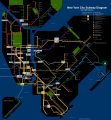




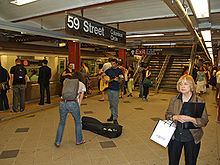










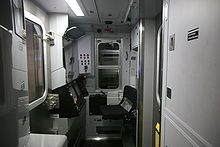
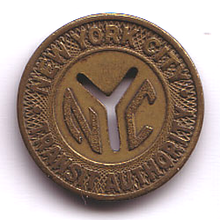


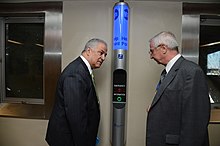












No comments:
Post a Comment
Please leave a comment-- or suggestions, particularly of topics and places you'd like to see covered